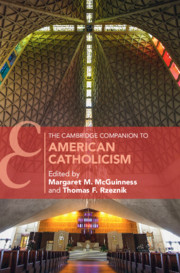Book contents
- The Cambridge Companion to American Catholicism
- Cambridge Companions to Religion
- The Cambridge Companion to American Catholicism
- Copyright page
- Contents
- Contributors
- Introduction
- Part I Historical Overview
- 1 American Catholicism’s Early Foundations
- 2 The Immigrant Church, 1820–1908
- 3 The Catholic Century
- Part II Catholic Life and Culture
- Part III The Many Faces of Catholicism
- Part IV Conclusion
- Index
- Series page
- References
3 - The Catholic Century
from Part I - Historical Overview
Published online by Cambridge University Press: 27 May 2021
- The Cambridge Companion to American Catholicism
- Cambridge Companions to Religion
- The Cambridge Companion to American Catholicism
- Copyright page
- Contents
- Contributors
- Introduction
- Part I Historical Overview
- 1 American Catholicism’s Early Foundations
- 2 The Immigrant Church, 1820–1908
- 3 The Catholic Century
- Part II Catholic Life and Culture
- Part III The Many Faces of Catholicism
- Part IV Conclusion
- Index
- Series page
- References
Summary
In June 1908, Pope Pius X published an apostolic constitution reorganizing the Roman curia. Apart from a few members of the clergy, virtually none of the roughly fourteen million Catholics in the United States in that year could have said, if asked, what an “apostolic constitution” was, nor could they have named the various departments in the remade curia or explain what any of them did. The church’s central administrative structures had no bearing on their religious lives or their identity as Catholics: Sunday Mass was the same next week as it had been last week. But the obscure papal decree had symbolic significance, even if laypeople were blissfully unaware of it. The responsibilities of one of those departments – the Sacred Congregation de Propaganda Fide (“Propagation of the Faith”), whose origins lay in the supervision of missionaries to China and Japan in the sixteenth century – encompassed, the pope said, “those regions in which, the sacred hierarchy not being yet constituted, the missionary state still exists.” By that standard, there were parts of the world that had once qualified as mission lands but now did not. Establishment of their own native churches had moved them into a different category. In 1850, for example, a system of dioceses and bishops had been reconstituted in Great Britain for the first time since the Reformation, allowing England and Scotland not to be considered missions anymore. In the New World, a century of growth also justified recognizing that the United States had ceased to be missionary territory; likewise Canada and Newfoundland (not yet a part of the Canadian confederation).1 In less than a sentence in the middle of a document about something else, the status of the Catholic Church in America had been changed. No longer an uncertain outpost, it was a regular part of the church worldwide, as much as that in Italy or France. Coming as it did at the opening of a new century, this technical papal order can be seen as marking the suitable beginning of a new era for the church in the United States.
- Type
- Chapter
- Information
- The Cambridge Companion to American Catholicism , pp. 48 - 66Publisher: Cambridge University PressPrint publication year: 2021



